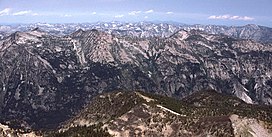TheBitterroot Rangeis amountain rangeand a subrange of theRocky Mountainsthat runs along the border ofMontanaandIdahoin the northwesternUnited States.The range spans an area of 24,223 square miles (62,740 km2) and is named after thebitterroot(Lewisia rediviva), a small pink flower that is thestate flowerof Montana.[1][2]
| Bitterroot Range | |
|---|---|
 Part of the Bitterroot Range in Montana, looking north from El Capitan peak | |
| Highest point | |
| Peak | Trapper Peak |
| Elevation | 10,157 ft (3,096 m) |
| Coordinates | 44°21′14″N112°49′17″W/ 44.353807°N 112.821407°W |
| Dimensions | |
| Length | 304 mi (489 km) N/S |
| Width | 268 mi (431 km) E/W |
| Area | 14,742 sq mi (38,180 km2) |
| Geography | |
| Country | United States |
| States |
|
| Parent range | Rocky Mountains |
History
edit1805, theCorps of Discovery,led byMeriwether LewisandWilliam Clarkand aided bySacajaweaof theShoshonetribe, crossed the Bitterroot Range several times. Lewis first crossed the mountains atLemhi Passon August 12, then returned across the pass to meet Clark. The entire expedition then crossed the pass to theSalmon Rivervalley, and the next month entered theBitterroot Valleyfrom the south via eitherLost Trail PassorChief Joseph Pass.It then crossedLolo Passto the west. In June 1806 the Corps of Discovery was then lead by 5 members of theNez Percéback across the Bitterroot Range, from west to east. The Bitterroots also presented a massive problem for the expedition, ending their hope of finding an all water Northwest Passage.[3]The mountains were crossed by theChicago, Milwaukee, St. Paul and Pacific Railroad(the "Milwaukee Road" ).[4]
Ranges
editAccording to theU.S. Board on Geographic Names,the Bitterroot Range runs fromPend Oreille Lake(nearSandpoint, Idaho) toMonida Pass,.[5]It is sometimes considered to extend east of the Monida Pass to include theCentennial Mountains.The range comprises the following subranges (from north to south):
Coeur d'Alène Mountains
editTheCoeur d'Alène Mountainsare the northwesternmost portion of the Bitterroot Range and encompass an area of 2,590 square miles (6,700 km2). The mountain range's two highest peaks are the7,352 foot (2,241 m)Cherry Peakand the6,837 foot (2,084 m)Patricks Knob.[6]
Saint Joe Mountains
editTheSaint Joe Mountains,the smallest named portion of the Bitterroot Range, encompass an area of698 square miles (1,808 km2).They lie between theSt. Joe Riveron the south, theCoeur d'Alene Riveron the north, the Slate Creek saddle on the east and the plateau of theMoscow, Idaho/Pullman, Washingtonarea on the Idaho/Washingtonborder.[7][8]
Bitterroot Mountains
editTheBitterroot Mountains,comprising theNorthernandCentral Bitterroot Ranges,are the largest portion of the Bitterroot Range and encompass an area of4,862 square miles (12,593 km2).The mountains are bordered on the north by Lolo Creek, on the south by theSalmon River,on the east by theBitterroot Riverand Valley,and on the west by theSelwayandLochsaRivers.[9]Its highest summit isTrapper Peak,at10,157 feet (3,096 m).[10][11]
Beaverhead Mountains
editTheBeaverhead Mountainsencompass an area of4,532 square miles (11,738 km2).They lie to the east of the Bitterroot Mountains and lie to the west of theBig Hole Basinand thePioneer Mountains.Passes in the mountains includeLemhi Pass,Bannock Pass,Big Hole Pass,Big Hole Pass II, Junction Pass andMonida Pass.The Beaverheads are further subdivided into theWest Big Hole Mountains,theBig Hole Divide,theTendoy Mountains,theItalian Peaks,and theGarfield Peaks.[12]
Centennial Mountains
editTheCentennial Mountainsencompass an area of2,064 square miles (5,346 km2).[13]
The Centennials are home toBrower's Spring,discovered in 1888 byJacob V. Brower,which is believed to be the furthest point on theMissouri River.Brower published his finding in 1896 in "The Missouri: Its Utmost Source."
The site of Brower's Spring is at about8,800 feet (2,680 m)in elevation in the Centennials. The site is now commemorated by a rock cairn at the source of Hellroaring Creek, which flows intoRed Rock Riverand then intoClark canyon reservoir,where it joins theBeaverhead Riverand then theBig Hole River,before ultimately joining with theJefferson River.[14]
In popular culture
edit- The Bitterroot Range is featured in the 2004alternate historynovel,Dies the Fire,byS.M. Stirling.
References
edit- ^"Bitterroot Range".Canadian Mountain Encyclopedia.Bivouac.com. Retrieved 4 March 2007.
- ^"Bitterroot Mountains".PeakBagger.RetrievedOctober 13,2012.
- ^Hallock, Thomas (1997)."Undaunted Courage: Meriwether Lewis, Thomas Jefferson, and the Opening of the American West by Stephen E. Ambrose".Western American Literature.31(4): 403–404.doi:10.1353/wal.1997.0020.ISSN1948-7142.
- ^Wood, Charles R. and Wood, Dorothy M., "Milwaukee Road West," (1972, Superior Publishing Co.).
- ^"Bitterroot Range".Geographic Names Information System.United States Geological Survey,United States Department of the Interior.RetrievedJuly 10,2010.
- ^"Coeur d'Alène Mountains".Peakbagger.com.RetrievedAugust 8,2011.Retrieved 4 March 2007.
- ^"Saint Joe Mountains".Peakbagger.com.RetrievedAugust 8,2011..Retrieved 4 March 2007.
- ^St. "Joe Mountains".Canadian Mountain Encyclopedia.Bivouac.com. Retrieved 4 March 2007.
- ^"Bitterroot Mountains".Canadian Mountain EncyclopediaBivouac.com. Retrieved 4 March 2007.
- ^"Northern Bitterroot Range".Peakbagger.com.RetrievedAugust 8,2011.Retrieved 4 March 2007.
- ^"Central Bitterroot Range".Peakbagger.com.RetrievedAugust 8,2011.Retrieved 4 March 2007.
- ^"Beaverhead Mountains".Peakbagger.com.RetrievedAugust 8,2011.Retrieved 4 March 2007.
- ^"Centennial Mountains".Peakbagger.com.RetrievedAugust 8,2011.Retrieved 4 March 2007.
- ^"The True Utmost Reaches of the Missouri - Montana Outdoors - July-August 2005".Archived fromthe originalon January 18, 2012.RetrievedApril 13,2007.
